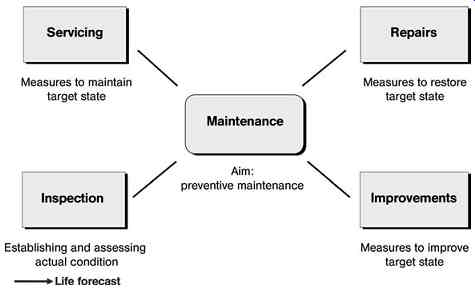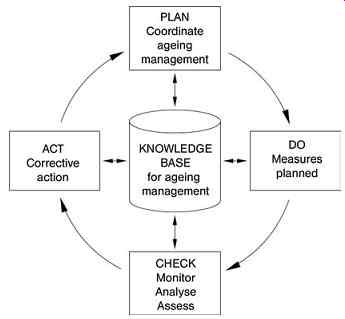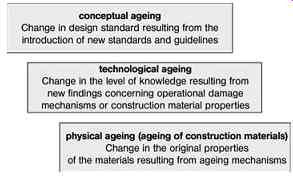AMAZON multi-meters discounts AMAZON oscilloscope discounts
1. Overview
To ensure that nuclear power plants are safe and reliable, the system components and structural systems must be built to the quality required. Life cycle management is generally defined as a combination of aging management and financial planning.
Aging management is thus part of life cycle management, and covers everything that the operators need to do to ensure that their nuclear power plants remain safe as they get older. The fundamental principles here are laid down by KTA 1403 which gives rules for aging management at nuclear power plants.
The main role of aging management in structural installations is to map what may happen to building materials as they age and prevent their having harmful effects specifically and effectively. These aging mechanisms are also known as physical aging: so aging management deals primarily with physical aging, with measures to ensure permanence and in particular the structural safety of building structures in use.
The term life cycle management is used instead of aging management if the focus is on financial aspects as well as structural safety. Life cycle management thus goes beyond aging management: as well as physical aging, it also includes conceptual aging and technological aging.
Conceptual aging covers changes to design standards due to introducing new rules such as standards and guidelines with altered requirements or changes to safety philosophy. These changes must be assessed to see how far they are relevant to the structural safety of buildings designed to the 'old' rules.
Technological aging covers changing findings in terms of possible harmful operating mechanisms and material characteristics. It also covers innovations in verification methods (changes to calculation standards) and testing and calculation methods. It is relatively unimportant in structural engineering compared with plant engineering, as the characteristics of the principal materials, concrete, reinforced concrete and building steel, have remained fundamentally unchanged for the past 40 years.
Like life cycle management, aging management involves maintaining buildings as knowledge-based preventive maintenance. This preventive maintenance covers the different measures involved in terms of maintenance, inspection, repairs and strengthening as shown in Figure 2.
2. Aging management of buildings
Aging management of nuclear power plants as built structures focuses on the structures that are safety-related. These structures are made of solid reinforced concrete, with the structural component dimensions not being governed by the effects of actions occurring involved in normal operation, but rather in terms of the requirements of protective effects against radiation and designed to cope with internal events, such as coolant loss, or rare external events, such as earthquakes, explosion pressure waves and aircraft impact.
Many of the factors that have to be considered as part of aging management occur in conventional structures just as much as they do in nuclear power plants, so that the knowhow and experience of harmful mechanisms in conventional structures can be applied directly. What is peculiar to nuclear power plants are the radioactivity and increased ambient temperatures which can cause materials to decay if exposed to them.
KTA 1403 divides structural systems into structures/substructures, construction systems and structural components. Structures/substructures are complete buildings or larger sections of buildings to be identified via the power plant coding system. Construction systems are groups of structural components that perform a common function, such as steel platforms, sealing against water pressure and structural fire protection elements. Construction systems consist of structural components such as anchor plates, fire doors and fire stop valves.
Structures/substructures, construction systems and structural components need to be classified in accordance with their safety requirements. For aging management purposes, those that need to be considered are those that are safety-related.

Fig. 2 Aging management concept
Building structures and buildings need to be checked regularly to see if they have departed from nominal in any way, such as faults due to subsoil settlement or cracking, corrosion or plastics losing their seal and protective functions. Conducted as preventive maintenance, these inspections can be used to detect aging mechanisms in good time and take appropriate follow-up measures to prevent serious damage.
3. Aging mechanisms in building materials
Aging mechanisms in building materials (physical aging) involve damage mechanisms which cause material characteristics to deteriorate, and which can be caused by the exposures below:
- mechanical attacks, such as stresses imposed by temperatures
- physical attacks (frost, temperature changes and humidity)
- chemical attacks (acids, alkalis etc.)
- biological attacks (bacteria and fungi).
These effects set off aging mechanisms which, for essential building materials, include:
- concrete: cracking, creep and shrinkage, swelling, secondary curing, carbonization, damage due to chloride or sulphate attack, alkali reaction, solvent attacks, such as by acids and salts, swelling sulphate attacks, growths (e.g. algae), radiation
- reinforcement steel, pre-stressing steel, construction steel: corrosion
- pre-stressed concrete: loss of tension due to creep and shrinkage
- plastics: fatigue
- coatings: bubbling, cracking, chalking.
Aging mechanisms can also be caused by changes to the subsoil, such as faults in building structures (cracks), operating problems (skewing turbine foundations etc.) due to the subsoil settlement under load, or deformations or changes of form in dykes through soil consolidation, sagging, settlements or external events.
4. Implementation and documentation
The measures required for aging management purposes depend on the maintenance strategy implemented. As well as the maintenance work itself, these include the inspections with regular tests and special tests, repairs and strengthening in the event of structural changes.
The basic procedure for conducting aging management to KTA 1403 is shown in Figure 3 (PDCA cycle). Aging management is knowledge-based, incorporating all information on structural systems and being constantly updated.
Inspections and structural examinations are used to establish what condition each structure is in, and to detect faults and changes. They are conducted at regular intervals in accordance with specified structural lists and the results recorded in status reports, so that trends can be followed in status reports and any faults observed can be assessed and repairs made.

Fig. 3 PDCA aging management cycle
Structural examination methods are laid down in instructions. Each examination is normally followed by visual checks, simple measurements or as part of geodetic survey programs, using preset criteria to specify more intensive examination methods.
In terms of reporting, KTA 1403 requires specific system basic reports, annual status reports and building status reports for structural systems (every 10 years). The basic report describes the process of aging management, including organization, and includes aging relevant findings. Status reports contain details of aging relevant activities and measures, findings and results during the reporting period. Building status reports are designed to show that safety-related structures have been assessed to see how they have aged.
Basic and status reports, which both cover mechanical engineering, electrical engineering and structural engineering, may also include individual specialist reports. For structural systems, for example, a 'Basic report - structural engineering' and 'Status report - structural engineering' (including building status report issues), can be prepared.
Prev. | Next
Home Similar
articles top
of page
